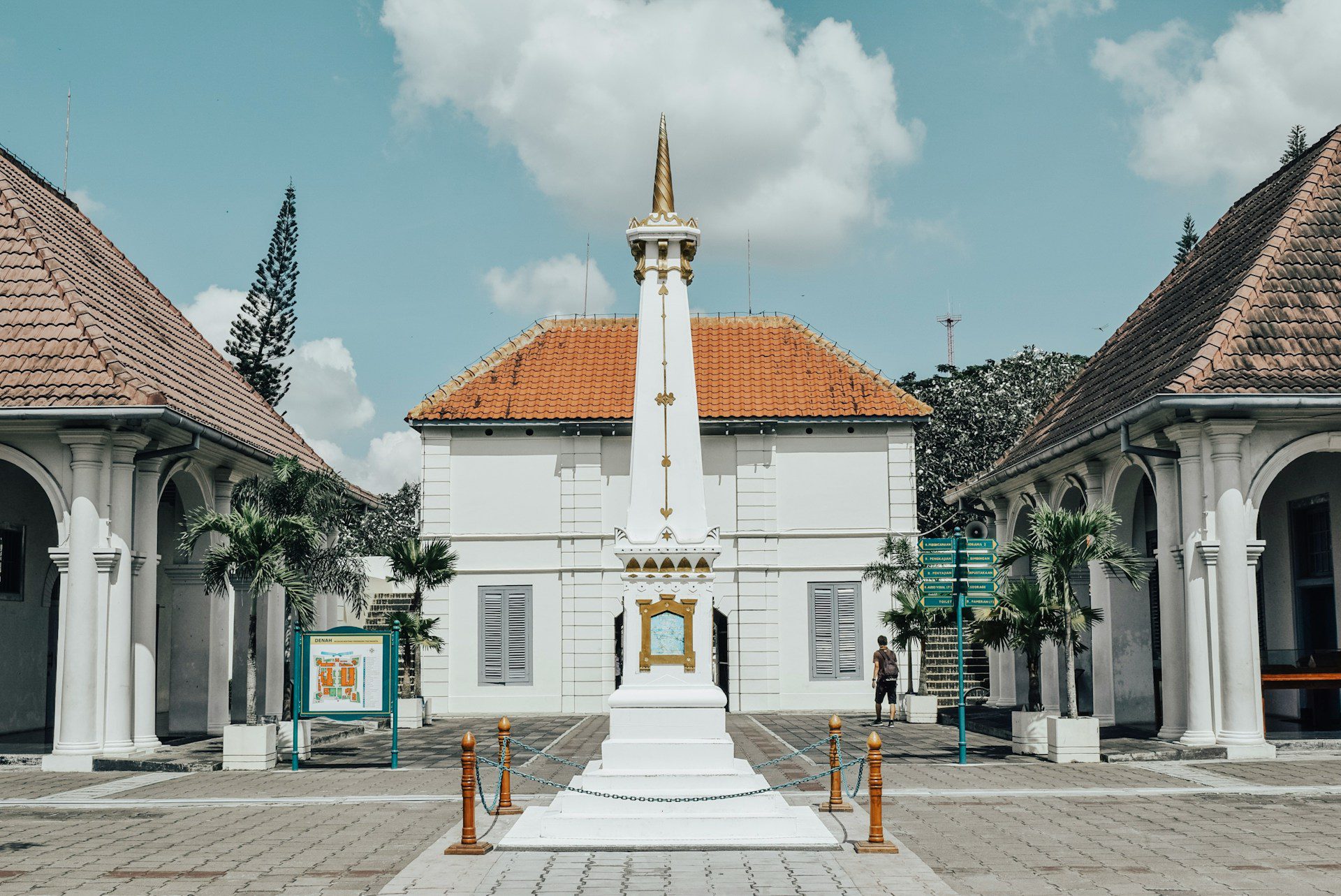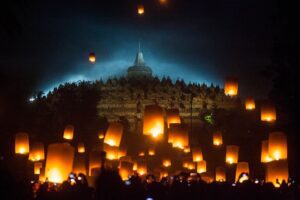Yogyakarta Philosophical Axis and its historical sites are located in the center of the city, which was established in 1756 by Prince Mangkubumi, the first Yogyakarta Sultanate monarch.
Prince Mangkubumi, who ruled over a large portion of Java and Madura from the late 16th century AD, was a prince of the Mataram Kingdom prior to his coronation in 1755 and the bestowal of the title Sri Sultan Hamengku Buwono I.
Surakarta Hadiningrat Sunanate (Surakarta) and Yogyakarta Hadiningrat Sultanate (Yogyakarta) were the two divisions of the Mataram Kingdom that occurred in 1755 due to internal conflicts over whether or not to cooperate with the Dutch East India Company colonial powers.
Prince Mangkubumi was the first Sultan of the Yogyakarta Sultanate, and he then started building the kingdom’s new capital and palace (kraton).
Yogyakarta Philosophical Axis
The Philosophical Axis of Yogyakarta is a deeply meaningful idea in spatial planning, setting it apart from other immediately identifiable world heritage sites or temple complexes based solely on their physical features.
The Yogyakarta Special Region’s official sources state that Yogyakarta’s Philosophical Axis is acknowledged as a worldwide legacy due to its universal relevance.
The first king of the Yogyakarta Sultanate, Prince Mangkubumi (Sri Sultan Hamengku Buwono I), originated this idea of spatial planning in the eighteenth century.
The idea of spatial planning, which is founded on cultural ideas from Java, entails building a network of straight highways that connect Panggung Krapyak in the south to Tugu Yogyakarta and Yogyakarta Kraton in the north.
What is the Significance of Yogyakarta Philosophical Axis
Like the well-known Javanese philosophical ideas, Yogyakarta’s Philosophical Axis is deeply significant.
This idea of spatial design, in its symbolism, stands for harmony and balance in human relationships with environment, with other humans, and with the divine.
The five elements—fire (dahana) from Mount Merapi, earth (bantala) from Ngayogyakarta, water (tirta) from the South Sea, wind (maruta), and ether (angkasa)—represent its relationship to nature.
The three components of life—body, energy, and soul—are also represented in this conceptual image of space.
Furthermore, the various Javanese customs and cultural practices observed in the vicinity, such as festivals, customary law, governance events, the arts, literature, and ritual ceremonies, provide evidence of cultural civilization associated with Yogyakarta’s Philosophical Axis.
Read more: Philosophy of the Meaning of the Yogyakarta Palace Logo
The Development of Yogyakarta
In the past, Sultan Hamengku Buwana I laid out a highly philosophical strategy for the development of Yogyakarta.
By erecting the Yogyakarta Palace in the middle of the city, Sultan Hamengku Buwana I lay out Yogyakarta in a north-south orientation.
Additionally, the Tugu Golong-gilig (White Pillar) was built by the Sultan on the palace’s northern side, and the Panggung Krapyak on its southern side. From these three places, one might draw a straight line that would subsequently be called the Philosophical Axis of Yogyakarta.
This hypothetical axis symbolizes the harmony and balance that exist in the interactions between people and their God (Hablun min Allah) as well as between people and other people (Hablun min Annas).
The philosophical axis also represents the harmony that exists between humanity and nature, meaning the five elements that make up nature: wind (maruta), water (tirta) from the South Sea, fire (dahana) from Mount Merapi, and ether (akasa).
The three components of life—the physical, the energetic, and the soul—are also included in this philosophical axis.
Sri Sultan Hamengku Buwana, also known as Sayidin Panatagama Kalifatullah, converted the Hindu notion of the philosophical axis into the Islamic philosophy of Java, which is known as Manunggaling Kawula lan Gusti and Hamemayu Hayuning Bawana.
1. The Lifecycle of Human (Sangkan Paraning Dumadi)
The spirit, or essence of life, is said to originate from and return to the Creator in the Javanese culture.
The meeting of positive (male) and negative (female) factors in the womb is the first step, and it results in birth, parental upbringing, and education.
By releasing oneself from materialism, one goes on to become an adult, get married, lead a prosperous life, and eventually get ready to return to the Creator.
Upon the Mataram kingdom’s adoption of Islam in the fifteenth century, Sufi ideas of the seven phases of the mystical journey were included.
Yogyakarta’s landmarks’ spatial arrangement reflects this Javanese life cycle. Crossing landmarks from south to north represents the journey from conception to returning to the Creator.
The obstacles in the way of overcoming materialism are symbolic. Ultimately, entering the Pangurakan Gate represents the union of the body and soul and the journey toward unity with the Creator.
According to this idea, the palace symbolizes heaven, accessible by going through seven gates that represent the seven pillars of Islam.
The burial procession of the Sultan towards the south represents the completion of the life cycle.
Read more: The Role of the Yogyakarta Palace in Preserving Javanese Culture and Arts
2. The Unity of God and Humanity (Manunggaling Kawula Gusti)
Javanese strength is their conviction that the only way to create perfect harmony in society is via unity between the rulers (Gusti) and the ruled (kawula), which can be taken as either God and the King (leader) or, depending on the situation, the King and his people.
The design of the city and the rites that take place there, especially at places like Bangsal Manguntur Tangkil, Alun-alun Utara, Tugu, and the Grand Mosque, reflect this idea.
At Bangsal Manguntur Tangkil, a notable location for ceremonies signifying the union of ruler and subjects, the Sultan meditates while gazing northward toward Tugu and Mount Merapi.
The Grand Mosque’s location in relation to Alun-alun represents the unity of God (Gusti), the King, and the people (all of whom are considered to be God’s servants). Sufi Islamic philosophy and Javanese philosophy are combined in these ideas.
According to the current Sultan, the axis that runs from the Kraton to Tugu symbolizes the Sultan’s responsibility to safeguard and promote the well-being of his subjects by supplying their material needs and employment opportunities (represented by Pasar Beringharjo and Gedung Administrasi Kepatihan), as well as by promoting religious observance.
Last but not least, Tugu represents the transcendent bond between God and humanity (Manunggaling Kawula Gusti).
3. The Harmonious Relationship between God, Humanity, and Nature (Hamemayu Hayuning Bawana)
Belief in the harmonious relationship between God, people, and nature—considered the three main components (matra) of the universe—is another important idea in Javanese cosmology that has materialized.
Each element is located in a distinct domain: Palemahan (the underworld’s natural realm), Pawongan (the tangible world’s human realm), and Parahyangan (the upper world’s gods’ realm).
A happy existence requires people to live in harmony with God, other people, and the natural world. Yogyakarta’s position, which is thought to consist of three interconnected primary components—Mount Merapi, Kraton, and the South Sea (Indian Ocean)—reflects this idea.
The Tugu, the Kraton, and Panggung Krapyak are the three principal monuments connected by Yogyakarta’s Philosophy Axis.
The Sultan adopted this idea to build a lovely and orderly world (Hamemayu Hayuning Bawana) when he designed the Kraton and Yogyakarta, signifying the duty of the entire Yogyakarta community to preserve harmony among the three primary components of existence (matra).
Read more: 10 Yogyakarta Palace Traditional Ceremonies and Traditions: Caring for Javanese Cultural Heritage
Yogyakarta Philosophical Axis: Tugu Jogja
The Tugu Golong-Gilig (Yogyakarta Monument) or people well-known as “Tugu Jogja”, the Kraton, and Panggung Krapyak are arranged in a straight line to form the Yogyakarta Palace’s Philosophical Axis.
Panggung Krapyak and Tugu Golong-Gilig, popularly called the White Pillar, stand in for Lingga and Yoni, which are symbols for fertility.
Originally known as Pal Putih, Tugu Golong-Gilig had a white painted cylindrical base (gilig) and a circular top (golong).
It represents the Sultan’s presence as he completes his journey through life. This is exhibited by real adoration of the Almighty, which is grounded in a pure heart (white color) and is complemented by a dedication to the welfare of the people (golong-gilig).
Thus, when the Sultan is meditating in the Bangsal Manguntur Tangkil at Sitihinggil Utara, Tugu Golong-Gilig is his main point of view.
The Philosophical Meanings
Sultan Hamengku Buwana I converted the Tugu, Kraton, and Panggung Krapyak’s intellectual relationship—which had originally had Hinduistic significance—into the Javanese Islamic philosophical idea known as Sangkan Paraning Dumadi.
The philosophy, known as sangkaning dumadi, stretches from Panggung Krapyak to the north and illustrates the path of a person’s life from conception to marriage and childbirth.
The South Square is a symbol of grown-ups who have gained the courage to court after attaining adulthood.
On the other hand, Sang Kholiq, or the journey of humanity towards God, is symbolized by Tugu Golong-Gilig towards the south (paraning dumadi).
With Margatama (the path to virtue), Golong-gilig represents the unity of thoughts, feelings, and intentions based on purity of heart (white color).
It then moves southward via Malioboro (using a torch or guidance of knowledge taught by the saints), Margamulya, and Pangurakan (dispelling negative desires).
The Kepatihan Complex and Beringharja Market serve as symbols of human wants and worldly temptations that should be resisted.
Gayam trees (Inocarpus edulis) denote shade, while tamarind trees (Tamarindus indica), which symbolize attractiveness, are placed along the Margatama, Malioboro, and Margamulya pathways.
Read more: The Lineage of the Yogyakarta Palace, From the Beginning to the Present
Embark on an unforgettable journey to Java, Indonesia, where a world of wonders awaits! Java, the heart and soul of Indonesia, is a treasure trove of diverse landscapes, rich cultural heritage, and breathtaking experiences.
Find out the package now from Yogyakarta Tours:
- 1 Day Tour:
- Multidays Tours





